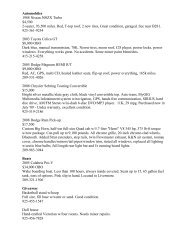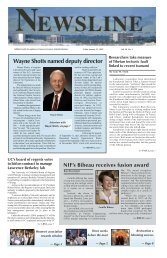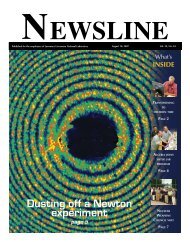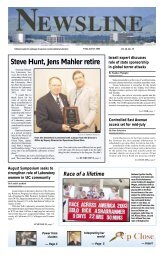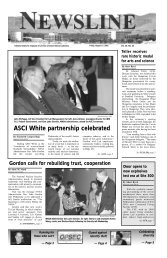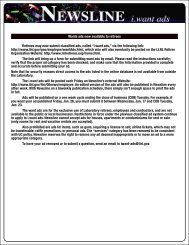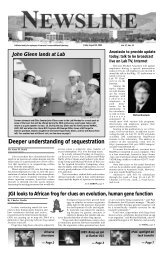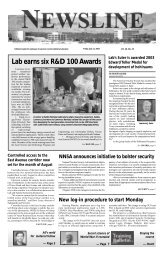What's INSIDE - NEWSLINE - Lawrence Livermore National ...
What's INSIDE - NEWSLINE - Lawrence Livermore National ...
What's INSIDE - NEWSLINE - Lawrence Livermore National ...
Create successful ePaper yourself
Turn your PDF publications into a flip-book with our unique Google optimized e-Paper software.
<strong>NEWSLINE</strong><br />
Published for the employees of <strong>Lawrence</strong> <strong>Livermore</strong> <strong>National</strong> Laboratory August 3, 2007<br />
Vol. 32, No. 23<br />
What’s<br />
<strong>INSIDE</strong><br />
final benefits<br />
package roll out<br />
– page 2<br />
Visualization<br />
pioneer honored<br />
– page 5<br />
a leg up for<br />
threatened frog<br />
– page 8
<strong>NEWSLINE</strong> August 3, 2007<br />
2007<br />
TRANSITION NEWS<br />
LLNS rolls out final benefits package<br />
<strong>Lawrence</strong> <strong>Livermore</strong> <strong>National</strong> Security, LLC (LLNS) and the University<br />
of California kicked off a series of presentations Tuesday further detailing<br />
LLNS benefits and the decisions employees will need to make about their<br />
UC benefits as part of the transition to the new contractor.<br />
Sharon Lyon of LLNS presented the elements of the LLNS benefits<br />
package and explained similarities with and differences from current UC<br />
benefits. Judy Ackerhalt of UC provided guidance on the options and<br />
decisions employees will have to make to transfer UC benefits to LLNS.<br />
Ralph Howard of the Lab’s Benefits Office facilitated the presentation<br />
in the Bldg. 123 auditorium and the audio-linked auxiliary auditoriums in<br />
Bldgs. 543, 482, 453 and 155.<br />
Lynn Soderstrom of LLNS and Ackerhalt fielded questions from<br />
employees in all auditoriums following the presentations.<br />
The depth and breadth of the presentation make it impractical to cover in<br />
Newsline. Employees are encouraged to consult the slides and the employee<br />
option matrix from the presentation, which are available from NewsOnLine<br />
(MY LLNL Front Page) and the LLNS Website, www.llnsllc.com. The<br />
Clockwise from top: Judy Ackerhalt of UC, Ralph Howard of the Lab’s<br />
Benefits Office and Sharon Lyon of LLNS.<br />
presentation also will be rebroadcast daily through Aug. 12 on Lab TV channel<br />
2 at 10 a.m., noon, 2, 4 and 8 p.m. and 4 a.m.<br />
A presentation for employees and their family members will be held<br />
Tuesday, Aug. 7, from 6:30-8:30 p.m., at the Shrine Event Center in <strong>Livermore</strong>,<br />
170 Lindbergh Ave., just off Airway Blvd. and Interstate 580.<br />
In addition, meetings specifically for retirees are scheduled for Aug. 7,<br />
from 10 a.m.-noon and on Aug. 8, from 9-11 a.m., at the La Quinta Inn, 7770<br />
Southfront Road in <strong>Livermore</strong> and on Tuesday, Aug. 14, from 9-11 a.m., and<br />
Wednesday, Aug 15, from 6:30-8:30 p.m., at the Shrine Event Center.<br />
Benefits information is available on the LLNS Website. Employees also may<br />
ask questions via the Website or by calling the LLNS hotline at 4-LLNS (5567).<br />
The UC Customer Service Center at 1-800-888-8267 or the LLNL Benefits<br />
hotline at 2-9955 is available for questions on UC benefits.<br />
LLNS-UC PRESENTATIONS FOR RETIREES<br />
Date Time Place<br />
Tuesday,<br />
Aug. 7<br />
Wednesday,<br />
Aug. 8<br />
Tuesday,<br />
Aug. 14<br />
Wednesday,<br />
Aug. 15<br />
LLNS-UC PRESENTATIONS FOR EMPLOYEES<br />
Date Time Place<br />
Tuesday, Aug. 7 6:30 - 8:30 p.m.<br />
Facility walkdowns<br />
10 a.m. - 12 p.m .<br />
9 - 11 a.m.<br />
9 - 11 a.m.<br />
6:30 - 8:30 p.m.<br />
Shrine Event Center<br />
170 Lindbergh Ave.<br />
<strong>Livermore</strong>, CA<br />
La Quinta Inn<br />
7700 Southfront Road<br />
<strong>Livermore</strong>, CA<br />
La Quinta Inn<br />
7700 Southfront Road<br />
<strong>Livermore</strong>, CA<br />
Shrine Event Center<br />
170 Lindbergh Ave.<br />
<strong>Livermore</strong>, CA<br />
Shrine Event Center<br />
170 Lindbergh Ave.<br />
<strong>Livermore</strong>, CA<br />
LLNS is conducting a series of “walkdowns” of many facilities on the<br />
Lab’s main site, Site 300 and the Nevada Test Site.<br />
The walkdowns and reviews of the Lab’s buildings are part of the<br />
second phase of the LLNS transition process. These are an assessment of the<br />
conditions of buildings and facilities and other infrastructure.<br />
The process will run through Aug. 21. There are six teams comprised of<br />
specially trained LLNS and LLNL ES&H and security subject matter experts.<br />
The goal is to conduct walkdowns of 100 percent of the buildings ranked<br />
higher than office category and a number of office facilities. Facility Points of<br />
Contact (FPOC) or other facility reps will accompany the teams. In addition,<br />
the daily schedules will be coordinated with the FPOCs and line management<br />
to accommodate ongoing programmatic work.<br />
Employees are asked to stop facility entry or stop a walkdown in progress<br />
if they observe unsafe, unsecure or non-compliant activities or conditions. For<br />
a complete summary of facility walkdowns, see next week’s Newsline.<br />
Have you received your LLNS job offer letter yet?<br />
If not, call the LLNS hotline, 4-LLNS (5567).
August 3, 2007<br />
Biweekly payroll changes<br />
Last day to make<br />
vacation election<br />
AUG. 30<br />
EXEMPT EMPLOYEES PAID BIWEEKLY<br />
October - December 2007<br />
Exempt Employees Pay Schedule<br />
Period Ending Pay Date<br />
Oct. 1 – 13 Oct. 19<br />
Oct. 14 – 27 Nov. 2<br />
Oct. 28 – Nov. 10 Nov. 16<br />
Nov. 11 – 24 Nov. 30<br />
Nov. 25 – Dec. 8 Dec. 14<br />
Dec. 9 – 22 Dec. 28<br />
Last day to arrange<br />
457(b) Deferred<br />
Compensation Plan<br />
contributions<br />
Last day to arrange a<br />
403(b) Plan Loan<br />
AUG. 31<br />
Last day to arrange<br />
Tax-Deferred 403(b)<br />
Plan contributions<br />
Last day to make tax<br />
and direct deposit<br />
changes through LAPIS<br />
self-service to aect<br />
nal UC paychecks<br />
SEPT. 14<br />
All UCRP and sick<br />
leave nal decisions<br />
due at 5 p.m.<br />
Last day to accept<br />
oer from LLNS, due<br />
no later than 5 p.m.<br />
SEPT. 17<br />
Photo by Jacqueline Mcbride<br />
LLNL Transition Manager Barbara Peterson briefs Lab administrative staff on the<br />
implementation of the new biweekly payroll schedule that will take effect Oct. 1.<br />
Last day of UC/LLNL<br />
Contract<br />
Non-exempt employees<br />
receive 2 paychecks, one<br />
for Sept. 9-22 and one for<br />
Sept. 23-30 (eight days)<br />
Exempt employees<br />
receive 1 paycheck for<br />
Sept. 1-30<br />
Employees choosing<br />
vacation cash out will<br />
receive an additional<br />
check<br />
SEPT. 28<br />
SEPT. 30<br />
First day to call FITSCo to arrange 403(b) loan repayments<br />
First day to arrange distributions from DC Plan,<br />
403(b) Plan and/or 457(b) Plan, if necessary<br />
First day of LLNS/LLNL Contract<br />
First day LLNL employees who accepted<br />
employment oer and elected inactive<br />
status in UCRP can retire from UCRP<br />
First day to request CAP distribution, if eligible<br />
All employees converted to bi-weekly pay<br />
Employee deductions automatically<br />
deducted over 26 weeks<br />
First day to make tax and direct deposit<br />
changes through LAPIS self-service to<br />
aect LLNS paychecks<br />
DEC. 30<br />
D E C I S I O N / A C T I V I T Y T I M E L I N E<br />
OCT. 1<br />
NON-EXEMPT EMPLOYEES PAID BIWEEKLY<br />
OCT. 2<br />
October - December 2007<br />
Non-Exempt Employees Pay Schedule<br />
Period Ending Pay Date<br />
Oct. 1 – 6 Oct. 12<br />
Oct. 7 – 20 Oct. 26<br />
Oct. 21 – Nov. 3 Nov. 9<br />
Nov. 4 – 17 Nov. 21<br />
Nov. 18 – Dec. 1 Dec. 7<br />
Dec. 2 – 15 Dec. 21<br />
OCT. 12<br />
First non-exempt<br />
LLNS paycheck for<br />
Oct. 1-6 (six days)<br />
First exempt LLNS<br />
paycheck for Oct.<br />
1-13<br />
OCT. 19<br />
Last day to set up<br />
payment with FITSCO<br />
for 403(b) loan.<br />
<strong>NEWSLINE</strong> 3<br />
Effective Oct. 1, LLNL will implement a new biweekly payroll schedule for<br />
exempt employees (currently monthly paid employees). The change in schedule<br />
is a direct result of California Labor Law. As a private entity, <strong>Lawrence</strong><br />
<strong>Livermore</strong> <strong>National</strong> Security, LLC (LLNS) must comply with all state codes<br />
and regulations. LLNL’s current practice is to pay exempt employees on the<br />
first day of the month for their work during the past month. Non-exempt<br />
employees at the Laboratory are already on a biweekly payroll schedule.<br />
The Laboratory’s Payroll Office is offering tools, briefings and a planning<br />
checklist to help prepare for this change.<br />
It should be noted that exempt status will not be affected by this change.<br />
Employees will continue to log their time and report as they do now. But the<br />
change will mean that employees are paid differently, receiving a portion of<br />
their income earlier than before. This will result in 26 paychecks per year and in<br />
this first year of implementation; exempt employees will receive approximately<br />
three weeks of income by the end of December 2007 that would have otherwise<br />
been paid in January 2008. Since this is unplanned income in the 2007 tax year,<br />
employees should plan for tax consequences accordingly.<br />
For more information, go to the Web at<br />
http://transition.llnl.gov/home/?url=payrollTimeline&id=95.<br />
Last day to elect UCRP<br />
retirement and convert<br />
sick leave to service<br />
credit (if you<br />
previously elected<br />
inactive status and<br />
chose to leave your sick<br />
leave balance with UC)<br />
JAN. 28, 2008
4 <strong>NEWSLINE</strong><br />
August 3, 2007<br />
SCIENCE NEWS<br />
Algae’s role in carbon cycle up close<br />
By Anne M. Stark<br />
Newsline staff writer<br />
Blue green algae are significant species in the global carbon cycle because they transform<br />
nitrogen gas from the atmosphere into a useable nutrient, enabling photosynthesis in<br />
nutrient-poor waters.<br />
Using NanoSIMS (high-resolution secondary ion mass spectrometer),<br />
Laboratory, USC and Portland State University scientists showed that they could<br />
image and track nutrient uptake in blue green algae at the nanoscale. The new<br />
method should help to clear up the age-old puzzle of how different species of blue<br />
green algae can “fix” or take up atmospheric nitrogen and carbon in a single cell<br />
organism. Carbon fixation during photosynthesis produces oxygen, which inhibits<br />
nitrogen fixation.<br />
Different species of blue green algae solve the problem in different ways<br />
and scientists still don’t understand how some of the most important species can<br />
get both of these jobs done.<br />
To develop the new method, the researchers studied the freshwater algae,<br />
Anabaena oscillarioides, which separates the two processes into adjacent cells that<br />
share the products. LLNL researchers Peter Weber, Jennifer Pett-Ridge, Stewart<br />
Fallon and Ian Hutcheon used NanoSIMS to track the uptake and movement of<br />
carbon and nitrogen inside two types of cells in the algae: vegetative cells, which<br />
perform carbon fixation, and heterocysts, thick-walled relatives that pull in nitrogen.<br />
NanoSIMS provides the ability to map distributions of elements and isotopes<br />
with 50-100-nanometer resolution. The device allowed the scientists to measure<br />
the carbon and nitrogen uptake and subsequent distribution at the cellular and<br />
subcellular level.<br />
“The method shows the dynamics of resource uptake and redistribution<br />
down to the level of sub-micron nitrogen storage and cell wall formation during cell<br />
division,” Weber said.<br />
The researchers used stable isotope tracers in nitrogen and carbon dioxide gases to track<br />
nitrogen and carbon fixation. After a few hours of incubation, vegetative cells exhibited a large<br />
enrichment in carbon and nitrogen isotopes because of active carbon and nitrogen uptake and<br />
intercellular exchange. During photosynthesis, most of the newly fixed carbon was allocated to<br />
vegetative cells because they are rapidly dividing, while heterocysts require very little carbon<br />
because they are non-growing cells.<br />
The NanoSIMS images showed that mature heterocysts are distinguishable from the<br />
vegetative cells based on their size, shape and intercellular distance. The method also<br />
showed that newly fixed nitrogen levels are higher in vegetative cells than in mature<br />
heterocysts.<br />
“We were able to see on a cell-by-cell basis how newly fixed nitrogen is rapidly<br />
exported from the heterocysts to vegetative cells, keeping pace with the nitrogen<br />
demands of the growing and dividing vegetative cells,” Weber said. “Now we can take<br />
these results and apply them to poorly understood species.”<br />
USC’s Kenneth Nealson predicts that NanoSIMS opens up a whole new field of<br />
study.<br />
“You can use this technology to look at things going on inside the cell,” he<br />
said. “This is going to change the way that we do a lot of microbiology.”<br />
The research appears in the latest issue of The International Society for Microbial<br />
Ecology (ISME) Journal.<br />
iMage courtesy of nasa<br />
iMage courtesy of nasa<br />
Cyanobacteria (blue green algae)<br />
live in the water, and can manufacture<br />
their own food. Because they<br />
are bacteria, they are quite small<br />
and usually unicellular, though they<br />
often grow in colonies large enough<br />
to see. They are one of the largest<br />
and most important groups of bacteria<br />
on earth.<br />
On the cover: The Baltic Sea<br />
blooms with life two times per<br />
year, once in the spring and once<br />
in the late summer. This true-color<br />
Aqua MODIS image shows the<br />
deep green swirls of the summer<br />
bloom around the Swedish island<br />
of Gotland. The summer bloom<br />
is usually caused by blue-green<br />
algae growing on the surface<br />
of the water. The algae thrive<br />
when ocean waters are warm<br />
and winds are calm; strong winds<br />
would churn the ocean, stirring the<br />
plants down into the water’s depths<br />
and keeping them away from the sunlight<br />
that they need to reproduce.
August 3, 2007<br />
<strong>NEWSLINE</strong> 5<br />
NOTABLE ACHIEVEMENTS<br />
Taking scientific visualization to the ‘Max’<br />
Jacqueline Mcbride/newsline<br />
Nelson Max of Computation will receive the Steven A. Coons Award<br />
for Outstanding Creative Contributions to Computer Graphics.<br />
LLNL’s Greg Simonson was presented the U.S. Air Force award for<br />
“Exemplary Civilian Service” by Air Force Maj. Gen. Robert Smolen.<br />
Nelson Max of Computation will<br />
receive the Steven A. Coons Award for<br />
Outstanding Creative Contributions<br />
to Computer Graphics at SIGGRAPH<br />
2007 in San Diego on Monday.<br />
This award, considered the highest<br />
award in the field of graphic, is given in<br />
odd-numbered years to an individual to<br />
honor that person’s lifetime contribution<br />
to computer graphics and interactive<br />
techniques. The award is presented<br />
to Max in recognition of his work in<br />
pioneering scientific visualization,<br />
his deep technical contributions, and<br />
the important role he has played in<br />
stimulating ideas and intellectual<br />
exchange in computer graphics.<br />
Max has a joint appointment with<br />
UC Davis and the Laboratory. His<br />
research interests include: realism in<br />
nature images; molecular graphics;<br />
computer animation; and 3D scientific<br />
visualization. He served as computer<br />
graphics director for the Fujitsu pavilions<br />
By Stephen Wampler<br />
Newsline staff writer<br />
Lab employee Greg Simonson has<br />
been honored with a U.S. Air Force medal<br />
for his efforts to help protect the nation’s<br />
capital and surrounding region from<br />
terrorist attacks.<br />
In a mid-June ceremony held at<br />
the Andrews Air Force Base Command<br />
Center, Simonson was presented the Air<br />
Force award for “Exemplary Civilian<br />
Service” by Air Force Maj. Gen. Robert<br />
Smolen.<br />
The award, consisting of a medal and<br />
a certificate, is usually given to civilian<br />
employees of the Department of Defense<br />
and rarely granted to non-DoD workers.<br />
Simonson has worked on assignment<br />
in Washington D.C. since November<br />
2006, serving as the senior scientist<br />
for the Counter-Chemical, Biological,<br />
Radiological, Nuclear and High Yield<br />
Explosives (CBRNE) center for the Air<br />
Force District of Washington.<br />
In his award citation, Simonson<br />
was recognized for his “distinguished<br />
performance.” The citation also noted that,<br />
“His efforts led to solutions that improve<br />
organic Counter-CBRNE response<br />
capabilities for the national capital region.”<br />
As chief scientist for the Counter<br />
CBRNE center, Simonson has worked<br />
at Expo 85 and 90 in Japan. Max<br />
received his doctorate in mathematics<br />
from Harvard University in 1967 and is<br />
a member of Association for Computing<br />
Machinery Siggraph.<br />
Previous recipients of this award<br />
include familiar names from film and<br />
television. Edwin Catmull worked<br />
at Lucasfilm and Pixar. He was a<br />
key developer of the RenderMan<br />
rendering system used in films such<br />
as “Toy Story” and “Finding Nemo.”<br />
Jim Blinn devised new methods<br />
to represent how objects and light<br />
interact in a three dimensional virtual<br />
world, like environment mapping<br />
and bump mapping. He is well<br />
known for creating animation for<br />
two television series: “Carl Sagan’s<br />
Cosmos: A Personal Voyage,” and<br />
the pioneering instructional graphics<br />
in “The Mechanical Universe.” His<br />
simulations of the Voyager spacecraft<br />
visiting Jupiter and Saturn have been<br />
Greg Simonson honored for anti-terrorism work<br />
caPt. adrianne Ketelsen<br />
with various governmental agencies,<br />
such as the Department of Homeland<br />
Security, the Department of Energy, and<br />
the Defense Threat Reduction Agency<br />
(DTRA), to move forward the best science<br />
and technology to help defend the nation’s<br />
capital region against terrorist attacks.<br />
Those efforts included bringing about<br />
the usage of a DHS and LLNL tool called<br />
the <strong>National</strong> Science and Technology<br />
Threat Awareness and Reachback, or<br />
NSTTAR. This capability consists of a<br />
group of subject matter experts and tools<br />
that tap resources at the Laboratory, other<br />
national labs and research centers to<br />
analyze threats and capabilities.<br />
A DTRA tool was also used by the<br />
Air Force District of Washington to assess<br />
the possible terrorist attack threats to<br />
Andrews Air Force Base.<br />
The Air Force District of<br />
Washington is one of the agencies<br />
responsible for security in the national<br />
capital region, which consists of<br />
the District of Columbia and seven<br />
surrounding counties in Maryland and<br />
Virginia.<br />
Prior to his Washington, D.C.<br />
assignment, Simonson headed the<br />
Lab’s Q Division (Proliferation,<br />
Detection and Defense Systems) from<br />
2000 to 2006, within what is now<br />
the Nonproliferation, Homeland and<br />
International Security Directorate.
<strong>NEWSLINE</strong> August 3, 2007<br />
i.want ads<br />
automobiles<br />
Ford F250 superduty, supercab, Lariat<br />
shortbed. $18,000. 19K miles, white<br />
w/gold trim. 707-647-1636<br />
1992 GMC Vandura, customized van.<br />
$2,800.
August 3, 2007<br />
RETIREES’ CORNER<br />
Gus Carlson (Mechanical Engineering,<br />
2000) proudly reports that Ace/Penguin<br />
has just published his son Jeff’s first novel.<br />
“Plague Year” is a high- tech thriller about the<br />
accidental release of a deadly self-replicating<br />
nanotechnology.<br />
Interestingly, one of the front cover “blurbs”<br />
is by former LLNL employee and New York<br />
Times bestselling author Kevin Anderson, who<br />
calls it “a grim and fascinating new twist on the<br />
post-holocaust story.” You can find cover art and<br />
the first two chapters at Carlson’s Website, www.<br />
jverse.com, along with book-signing dates in the<br />
Bay Area and advance information on the sequel,<br />
“War Day,” coming from Ace in Summer 2008.<br />
Gus (Engineering Directorate, 1993) and<br />
Jane (Mechanical Engineering, 1993) Olson,<br />
along with Jackie and Alan Mode (NAI, 2000)<br />
and granddaughter, Brittany, recently took a<br />
WHERE TO FIND TRANSITION INFORMATION ON THE WEB<br />
WHAT WHERE<br />
Biweekly payroll information LLNL transition site, newsroom<br />
UC Decision Guide LLNL transition site, newsroom<br />
Decision/activity timeline LLNL transition site, coming events<br />
Benefits meetings LLNL transition site, coming events<br />
LLNS and UC benefits meeting presentations LLNL transition site, newsroom<br />
Town Hall meeting presentations LLNL transition site, key documents<br />
Submit questions LLNL transition site, FAQ<br />
Accept/decline offer letter LAPIS https://psapp.llnl.gov/psp/ps89prd/?cmd=login<br />
LLNS hotline LLNS, benefits<br />
Approved compensation package summary LLNS, benefits<br />
LLNS benefit package briefing LLNS, benefits<br />
UC transition support slides LLNS, benefits<br />
Benefit briefing handout LLNS, benefits<br />
NNSA white paper on benefits LLNS, benefits<br />
Benefits meetings LLNS, benefits<br />
Sample decision form LLNS, offer letter<br />
Sample offer letter LLNS, offer letter<br />
Online acceptance procedure LLNS, offer letter<br />
Dispute resolution program summary LLNS, offer letter<br />
UC benefits information http://atyourservice/ucop.edu<br />
Benefits directory LLNS, Q&A<br />
Submit questions LLNS, Q&A (benefits)<br />
Key personnel LLNS, About Us, leadership team<br />
Organization chart LLNS, About Us, leadership team<br />
Quail for Future Farmers of<br />
America school project. 925-<br />
449-1294<br />
Reunion. Alameda County<br />
4H’ers for an all county reunion<br />
of leaders and members from<br />
1955 to present. 925-371-0507<br />
Special needs babysitter.<br />
Responsible college or high<br />
school student needed to<br />
babysit 15 year old boy with<br />
autism 2-3 afternoons a week<br />
from 3-6 p.m. Great pay. Must<br />
drive, enjoy walks, bookstores,<br />
watching videos. Call 443-<br />
3396 (evenings)<br />
Towing drawbar. Need Class<br />
II rated (3500lbs drawbar,<br />
1.25 inch square receiver)with<br />
minimal drop/rise. 209-892-<br />
1918<br />
Treadmill.-Spacesaver. Looking<br />
for low priced electric foldup/spacesaver<br />
treadmill to<br />
encourage diabetic relative to<br />
get healthy 925-518-7600<br />
cruise — a land/sea tour in Alaska. They went<br />
to Fairbanks for one day, Denali for two days,<br />
Anchorage for three days, and a three-day cruise<br />
on Prince Williams Sound. They saw moose, bears,<br />
many species of birds and Iditarod sled teams.<br />
They also saw Mount McKinley, many glaciers,<br />
waterfalls and some of the most beautiful scenery<br />
in North America. They enjoyed the 23-hours<br />
of daylight. They attended a July 4 party with<br />
Alan’s daughter and family, although there were no<br />
fireworks since there was no darkness. (See retiree<br />
Webpage for more details.)<br />
The August retirees’ luncheon will be held<br />
at noon on Wednesday, Aug. 15, at the Elks<br />
Lodge in <strong>Livermore</strong>. The speaker will be George<br />
Farquar. The title of his talk is: “Homeland<br />
Security Applications of Single Particle Aerosol<br />
Mass Spectrometry: Recent Developments at<br />
LLNL.” Farquar is currently a research scientist<br />
Wanted: small car. Need<br />
small automatic car for college<br />
student. 209-531-1527<br />
Wanted: Agapanthus (Lily of the<br />
Nile). 209-403-1854<br />
Wanted: Woman’s bicycle.<br />
hybrid or mt. bike in good<br />
condition 454-0877<br />
Needed: Toddler bed with side<br />
railings. 925-819-6018<br />
<strong>NEWSLINE</strong><br />
Newsline is published bi-weekly by the Public Affairs<br />
Office, <strong>Lawrence</strong> <strong>Livermore</strong> <strong>National</strong> Laboratory<br />
(LLNL), for Laboratory employees and retirees.<br />
Public Affairs Office: L-797 (Trailer 6527),<br />
LLNL, P.O. Box 808, <strong>Livermore</strong>, CA 94551-0808<br />
Telephone: (925) 422-4599; Fax: (925) 422-9291<br />
e-mail: newsline@llnl.gov or newsonline@llnl.gov<br />
Web site: http://www.llnl.gov/pao/<br />
Distribution: Mail Services at LLNL<br />
<strong>NEWSLINE</strong> 7<br />
PEOPLE NEWS<br />
in the Chemistry, Materials, and Life Sciences<br />
Directorate studying aerosol mass spectrometry<br />
for homeland security and environmental<br />
applications. He was a Glenn T. Seaborg<br />
Institute postdoctoral fellow at LLNL where<br />
he expanded the use of Bioaerosol Mass<br />
Spectrometry (BAMS) detection to include<br />
explosives, chemical warfare agents and drugs.<br />
Gus and Jane Olson have found someone who<br />
might be interested in taking over the Retirees’<br />
Corner, but if anyone else is interested, contact<br />
them. The only requirement is that you have a<br />
computer and e-mail. Perhaps someone who is<br />
retiring soon would enjoy this volunteer job. If<br />
you are interested, call them at 925-443-4349.<br />
Send any input to Jane or Gus Olson. E-<br />
Mail: AugustO@aol.com or JaneRubert@aol.<br />
com. Snail mail address: 493 Joyce Street,<br />
<strong>Livermore</strong>, CA 94550.<br />
Newsline editor: Don Johnston, 3-4902<br />
Contributing writers: Bob Hirschfeld, 2-2379; Linda<br />
Lucchetti, 2-5815; David Schwoegler, 2-6900;<br />
Anne M. Stark, 2-9799; Stephen Wampler, 3-3107.<br />
Photographer: Jacqueline McBride, 2-0175<br />
Designers: Julie Korhummel, 2-9709;<br />
Kathleen Smith, 3-4769<br />
For an extended list of Lab beats and contacts, see<br />
http://www.llnl.gov/pao/contact/
8 <strong>NEWSLINE</strong><br />
August 3, 2007<br />
SCIENCE NEWS<br />
Survival strategies of the California red-legged frog<br />
By Karen Jensen<br />
The federally protected California redlegged<br />
frog (Rana aurora draytonii) can be found<br />
in streams, ponds, marshes and artificial water sources such<br />
as stock ponds. Here at the Laboratory, you might observe these crimson hued<br />
creatures at Lake Haussmann and Arroyo Las Positas, or in the wetlands of Elk<br />
Ravine and Gooseberry Canyon at Site 300.<br />
Often these aquatic habitats available to frogs are isolated from each<br />
other by wide expanses of terrestrial habitat. These seemingly isolated<br />
frog populations are linked together to form a larger group referred to as a<br />
metapopulation.<br />
The populations of frogs that make up the metapopulation operate<br />
independently of each other. However, during certain times of the year, some<br />
frogs will travel beyond their usual pond either to the surrounding terrestrial<br />
habitat in search of food or shelter, or to migrate to another aquatic habitat.<br />
Throughout the summer months, California red-legged frogs often move<br />
into terrestrial areas to forage and seek shelter. During this period, frogs can<br />
be found under boulders or rocks and organic debris, such as downed trees<br />
or logs; industrial debris; and agricultural items like drains, troughs or sheds.<br />
Small burrows, like those made by ground squirrels, provide an important<br />
u.s. fish and wildlife service.<br />
Above: Aerial view of California red-legged frog breeding<br />
(aquatic) habitat surrounded by terrestrial habitat. Inset:<br />
An adult California red-legged frog wearing a radiotransmitter.<br />
This is a device that can help biologists study<br />
movement and habitat use within the metapopulation.<br />
Background image: This wetland at Elk Ravine is used by<br />
California red-legged frogs. credit: corey cate<br />
Photo by<br />
Michael van hattaM<br />
safe haven from the intense summer heat. Moist leaf<br />
litter and narrow stream channels also allow the frogs to<br />
hunker down, waiting for the fall rains. Frogs will even use<br />
the deep cracks of drying ponds, anything that provides shade, cooler<br />
temperatures, and a bit of moisture.<br />
During periods of wet weather, some frogs use the rain to travel<br />
overland and settle in new aquatic habitats. This usually begins with<br />
the first rains of the fall and most of these overland movements happen<br />
at night. Frogs can travel under these conditions for distances of more<br />
than 1.9 miles (3 kilometers) with no apparent regard to topography,<br />
vegetation type or riparian corridors.<br />
Movements of individual frogs throughout the metapopulation<br />
allows for the exchange of individuals and recolonization in the event<br />
of a local extinction. Access to appropriate terrestrial habitat allows the<br />
frogs to survive throughout periods of drought and heat.<br />
Biologists and resource managers are attempting to understand the<br />
survival strategies of the California red-legged frog. One thing is certain:<br />
the frogs, not only at LLNL’s sites but throughout the region, have the<br />
greatest chance of survival when there are multiple areas of suitable<br />
aquatic habitat connected by suitable terrestrial habitat.<br />
NON-PROFIT ORG.<br />
U.S. POSTAGE<br />
PAID<br />
LIVERMORE, CA<br />
PERMIT NO. 154<br />
Newsline<br />
UC-LLNL<br />
PO Box 808, L-797<br />
<strong>Livermore</strong>, CA 94551-0808<br />
An adult California red-legged frog.<br />
Photo by Michael van hatteM, ePd




